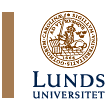

|
Panel No. 21Panel Title: Localities, Situated Knowledges and GlobalizationsConvenor: Satu Ranta-Tyrkkö, Dept. of Social Policy and Social Work, University of Tampere, Finland Thursday 8 July, 8–12 Panel Abstract: These days it is
easy to see reflections to globalization at different localities
in South Asia. Also studies of different local communities or local
phenomena tell, through their particularity, stories about wider
regional, national and global processes and their implications –
or do they? It is indisputable that localities are facing and transformed
by change justified, for instance, by regional or national development
programs. Though the localities are not any stable entities as such,
the local view to changes can be somewhat different than at the
other end of the processes.
Papers accepted for presentation in the panel:Paper Giver 1: Marie Larsson, Department of Social Anthropology, Stockholm University, Sweden Paper 1 Title: The 'Imagined Community' of the Anti-Arrack Movement Paper Abstract: In 1991 women from Dubagunta, Nellore District in Andhra Pradesh drove the liquor contractors out of their village. This is supposed to have been the beginning of the so-called Anti-Arrack Movement (Saara Vyathireka Udyamam) that finally led to prohibition of alcohol in the state, on the 16th of January 1995. The main participants were poor, rural women, mainly from Scheduled Castes and Backward Classes, supported by voluntary organizations and later on by politicians from the opposition parties. The aim of this paper is to describe the processes whereby a larger movement identity was created. How can people engaged in their own everyday concerns be mobilised to join a translocal movement? I will begin by focusing on networks between common activists and movement organisations. Thereafter I will describe the role of the press for the spread of the movement. The paper will then centre on 'rituals of protest', exemplified by the foot march (padhyatra) between different villages in Nellore district as well as meetings and demonstrations at which women from the rural areas gathered. Finally, I will touch on the role of music and street theatre as carriers of local traditions and cultural change. Paper giver 2: Nandita Singh, Department of Land and Water Resources Engineering, Royal Institute of Technology (KTH), Sweden Paper 2 Title: Water management traditions in rural India: Valuing the unvalued
Paper Abstract: Achieving effective and efficient management
of water as the key to human survival and development has emerged
as an urgent global concern. The realization of the limited availability
of water in space and time under conditions of ever-increasing pressures
has caused designing of 'modern' water management initiatives that
are globally manufactured but implementable in local communities,
India being no exception. It is perhaps universally assumed that
water management, as an integrated system based upon local knowledge
& practices, is either 'non-existent' or 'irrational', 'narrowly
pragmatic' and 'in the process of disappearance'. If water is a
basic resource necessary for sustaining all human activities, its
provision in the desired quantity and quality and at the right time
and place through a workable local water management system must
be regarded as an omnipresent phenomenon. How is water management
traditionally organized in rural Indian localities so that the community's
needs are met through generations? What implications do such systems
based in local knowledge & practices hold for the global water
management context? Full paper to be downloaded (as a pdf-file) Paper giver 3: Jonathan Pattenden, SOAS, London, UK Paper 3 Title: Social bases of the Karnataka State Farmers' Association (KRRS) Paper Abstract: N.A. Paper giver 4: Satu Ranta-Tyrkkö, Department of Social Policy and Social Work, University of Tampere, Finland Paper 4 Title: Village as a Source of Identity and a Point of Reference for the Theatre Group Natya Chetana Paper Abstract: Natya Chetana (Theatre for Awareness) is an Orissan theatre group. In my on-going Ph.D. work I look at Natya Chetana as a local application of theatre and social work, and explore Natya Chetana, its work and significance in its own context. The group, founded in 1986, used to be based in the state capital Bhubaneswar, but moved lately to live in countryside in its own "theatre village", Natya Gram. My presentation deals with the relationship Natya Chetana has with a village or villages in Orissa. My main interest is to look at the metaphorical level of the relationship, which I see as a tale of "the" village as a source of identity and people's culture, and the origin of folk performing arts. By its theatre style, loko natya, translated by Natya Chetana as people's theatre, the group is and claims to be strongly committed to local genres of folk performing arts. While doing so, Natya Chetana is careful to assure that it is not doing pure folk theatre, but modern, Indian, awareness creating theatre, that has its roots in local (folk) performance art traditions and idioms. My presentation focuses on the following aspects: (1) The importance of village in the construction of identity - more so than as a way of being and living. For many of the members of Natya Chetana village seems to represent home, or at least a source of identity, even though they have lived in Bhubaneswar or other towns most of their life. As a collective effort and a way of life, the group's theatre village, Natya Gram, is more an ashram than a village, though named as one. I see the naming and the partly "village-like" way of life to serve a greater tale, the group's narration/ fiction of an idealized village lifestyle and identity. This is closely linked with the idea of (2) village as the source of folk art and genuine indigenous talent and expression. However, (3) everything in village is not ideal for Natya Chetana. The representations of village in Natya Chetana's theatre work often show village as a place of tensions, power-games, corruption and fight for survival. Paper giver 5: Hans Andersen, Roskilde University, Denmark Paper Title: The Political Village Studying Politics From Below Paper abstract: This paper examines how villages can be drawn into political processes revolving around national and global political forces. The study of how villages transform through the encounter with political organisations and ideas on the 'outside' may help understand not only the politics on the 'inside' of a local community, but also the political fabric of the wider society. During recent field research in Nepal, studying politics through the lens of villagers proved an effective point of departure for analysing the informal intricacies of a political system. The village provided a 'window' through which to study the district and centre. The paper examines two recent periods in Nepal the first characterised by multi-party competition and decentralisation (1992-2002); and the second by autocratic rule and centralisation (2002 onwards). During these two periods, local communities were exposed to dramatic change. Following the villagers as they ventured upwards through the 'tentacles' of the state, on the one hand, and showing how higher-level politicians and bureaucrats intervened at the local level, on the other, it became apparent that village politics is both conditioned by and feed back into outside forces. In our era of globalisation the village is rarely an isolated unit. Yet retaining it as a unit of analysis, the paper shows, can be a fruitful approach. Full paper to be downloaded (as a pdf-file)
SASNET - Swedish South Asian Studies Network/Lund
University
|

